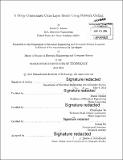A delay-constrained cross-layer model using network coding
Author(s)
Adams, David C. (David Christopher)
DownloadFull printable version (6.923Mb)
Other Contributors
Massachusetts Institute of Technology. Department of Electrical Engineering and Computer Science.
Advisor
Muriel Médard and Christopher Yu.
Terms of use
Metadata
Show full item recordAbstract
Traditionally, most packet-switched networks have only one wireless hop: the link between the end users and their access point. However, there is increasing interest in using wireless links to reach the edge of the network. Having more than one wireless link is a game changer. Network layer architecture is predicated on the assumption that the lower layers are reliable, but this comes at a high cost in terms of data rate on a band-limited, lossy wireless channel. This cost is tolerable over one underutilized link, but when the network demands high-capacity wireless links, it may be time to rethink the way the packet-switched network interacts with its underlying infrastructure. The aim of this thesis is to provide a general model that can be used to frame a wide variety of cross-layer coding problems. We do not explicitly consider the channel code, medium access, or modulation; instead, we leverage the maturity of these fields to observe the general effect they produce on higher layers. We focus our model on applications where delay is constrained, which forces us to consider coding results in the regime where code length is non-asymptotically large. In trying to extend our analysis to multi-hop flows, we develop an analytical tool that can be useful in wider applications. This tool simplifies certain network flows to a distribution on the amount of information available to the destination; it is a step towards characterizing network information flows in the non-asymptotic regime. Finally, we will use the model to design encoding schemes, given practically-motivated constraints.
Description
Thesis: S.M., Massachusetts Institute of Technology, Department of Electrical Engineering and Computer Science, 2014. 27 Cataloged from PDF version of thesis. Includes bibliographical references (pages 79-81).
Date issued
2014Department
Massachusetts Institute of Technology. Department of Electrical Engineering and Computer SciencePublisher
Massachusetts Institute of Technology
Keywords
Electrical Engineering and Computer Science.